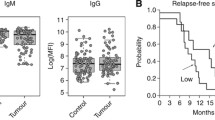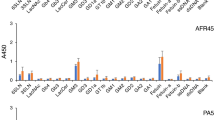Abstract
Humanized monoclonal antibody HMMC-1 established by immunizing transchromosomal mice with a human uterine endometrial cancer cell line has been found to react with the H-antigen carried on core l O-glycans through cotransfection of glycosyltransferases for O-glycans and inhibition of antibody-binding with synthetic oligosaccharides. However, direct binding analysis of an antibody against glycosphingolipids from human erythrocytes with different ABO blood groups revealed that it was able to bind selectively with polar glycolipids in blood group O, but not blood group A, B and AB erythrocytes. Unexpectedly, typical monofucosylated H-glycolipids, IV2Fucα-nLc4Cer and VI2Fucα-nLc6Cer, which are the precursors for A and B-glycolipids, and were present not only in blood group O, but also A, B and AB-erythrocytes, were not the antigens for the HMMC-1 antibody. The antigen comprised less than 0.001% of the total glycolipids in blood group O-erythrocytes, and was purified by conventional silica gel column chromatography. Structural determination by permethylation, GC-MS, and ESI-TOFMS demonstrated that the structure was a novel glycolipid with a difucosylated H-antigen, Fucα1–2Galβ1-4GlcNAcβ1–3Gal(2-1αFuc)β1-4GlcNAcβ1–3Galβ1-4GlcNAcβ1–3Galβ1-4Glcβ1–1’Cer, VI2,VIII2(Fucα)2-nLc8Cer, whose terminal difucosylated structure was the epitope of the HMMC-1 antibody. The HMMC-1 glycolipid was detected in five out of 29 tissues from patients suffering from uterine cervical carcinomas, irrespective of their ABO-blood groups.




Similar content being viewed by others
References
IUPAC-IUB: Commission on biochemical nomenclature of lipids. Eur. J. Biochem. 179, 11–21 (1977)
Nozawa, S., Aoki, D., Tsukazaki, K., Susumu, N., Sakayori, M., Suzuki, N., Suzuki, A., Wakita, R., Mukai, M., Egami, Y., Kojima-Aikawa, K., Ishida, I., Belot, F., Hindsgaul, O., Fukuda, M., Fukuda, M.N.: HMMC-1: a humanized monoclonal antibody with therapeutic potential against Müllerian duct-related carcinomas. Clin. Cancer Res. 10, 7071–7078 (2004)
Kościelak, J., Plasek, A., Górniak, H., Gardas, A., Gregor, A.: Structures of fucose-containing glycolipids with H and B blood-group activity and of sialic acid and glucosamine-containing glycolipid of human-erythrocyte membrane. Eur. J. Biochem. 37, 214–225 (1973)
Fukuda, M.N., Levery, S.B.: Glycolipids of fetal, newborn, and adult erythrocytes: glycolipid pattern and structural study of H3-glycolipid from newborn erythrocytes. Biochemistry. 22, 5034–5040 (1983)
Iwamori, M., Murata, M., Toyoda, M., Iwamori, Y.: Contribution of glycolipids to species-specific antigens on erythrocytes of several animal species as to recognition of antigens with rabbit anti-glycolipids and anti-erythrocyte antisera. Glycoconj. J. 26, 467–476 (2009)
Iwamori, M., Sakai, A., Minamimoto, N., Iwamori, Y., Tanaka, K., Aoki, D., Adachi, S., Nomura, T.: Characterization of novel glycolipid antigens with an α-galactose epitope in lactobacilli detected with rabbit anti-lactobacillus antisera and occurrence of antibodies against them in human sera. J. Biochem. 150, 515–523 (2011)
Tanaka, K., Miyazawa, M., Mikami, M., Aoki, D., Kiguchi, K., Iwamori, M.: Enhanced expression of unique gangliosides with GM2-determinant in human uterine cervical carcinoma-derived cell lines. Glycoconj. J. 33, 745–754 (2016)
Tiltman, A.J.: The pathology of cervical tumours. Best Pract. Res. Clin. Obstet. Gynaecol. 19, 485–500 (2005)
Sugiyama, T., Miyazawa, M., Mikami, M., Goto, Y., Nishijima, Y., Ikeda, M., Hirasawa, T., Muramatsu, T., Takekoshi, S., Iwamori, M.: Enhanced expression of sulfatide, a sulfated glycolipid, in well-differentiated endometrial adenocarcinoma. Int. J. Gynecol. Cancer. 22, 1192–1197 (2012)
Iwamori, M.: A new turning point in glycosphingolipid research. Hum. Cell. 18, 117–133 (2005)
Feizi, T.: Demonstration by monoclonal antibodies that carbohydrate structures of glycoproteins and glycolipids are onco-developmental antigens. Nature. 314, 53–57 (1985)
Abe, K., Levery, S.B., Hakomori, S.: The antibody specific to type 1 chain blood group a determinant. J. Immunol. 132, 1951–1954 (1984)
Clausen, H., McKibbin, J.M., Hakomori, S.: Monoclonal antibodies defining blood group a variants with difucosyl type 1 chain (ALeb) and difucosyl type 2 chain (ALey). Biochemistry. 24, 6190–6194 (1985)
Clausen, H., Levery, S.B., Nudelman, E., Baldwin, M., Hakomori, S.: Further characterization of type 2 and type 3 chain blood group a glycosphingolipids from human erythrocyte membranes. Biochemistry. 25, 7075–7085 (1986)
Lin, B., Hayashi, Y., Saito, M., Sakakibara, Y., Yanagisawa, M., Iwamori, M.: GDP-fucose: β-galactoside α1,2-fucosyltransferase, MFUT-II, and not MFUT-I or -III, is induced in a restricted region of the digestive tract of germ-free mice by host-microbe interactions and cycloheximide. Biochim. Biophys. Acta. 1487, 275–285 (2000)
Lin, B., Saito, M., Sakakibara, Y., Hayashi, Y., Yanagisawa, M., Iwamori, M.: Characterization of three members of murine α1,2-fucosyltransferases: change in the expression of the se gene in the intestine of mice after administration of microbes. Arch. Biochem. Biophys. 388, 207–215 (2001)
Marionneau, S., Bureau, V., Goupille, C., Hallouin, F., Rocher, J., Vaydie, B., Le Pendu, J.: Susceptibility of rat colon carcinoma cells to lymphokine activated killer-mediated cytotoxicity is decreased by alpha1,2-fucosylation. Int. J. Cancer. 86, 713–717 (2000)
Le Pendu, J., Marionneau, S., Cailleau-Thomas, A., Rocher, J., Le Moullac-Vaidye, B., Clément, M.: ABH and Lewis histo-blood group antigens in cancer. APMIS. 109, 9–31 (2001)
Goupille, C., Marionneau, S., Bureau, V., Hallouin, F., Meichenin, M., Rocher, J., Le Pendu, J.: alpha1,2Fucosyltransferase increases resistance to apoptosis of rat colon carcinoma cells. Glycobiology. 10, 375–382 (2000)
Iwamori, M., Tanaka, K., Kubushiro, K., Lin, B., Kiguchi, K., Ishiwata, I., Tsukazaki, K., Nozawa, S.: Alterations in the glycolipid composition and cellular properties of ovarian carcinoma-derived RMG-1 cells on transfection of the α1,2-fucosyltransferase gene. Cancer Sci. 96, 26–30 (2005)
Author information
Authors and Affiliations
Corresponding author
Ethics declarations
Conflict of interest
The authors declare that they have no conflicts of interest.
Ethical approval
This article does not contain any studies with human participants or animals performed by any of the authors.
Additional information
Publisher’s note
Springer Nature remains neutral with regard to jurisdictional claims in published maps and institutional affiliations.
Abbreviations used
The nomenclature for glycolipids is based on the recommendations of the IUPAC-IUB Commission on Biochemical Nomenclature [1].
Rights and permissions
About this article
Cite this article
Tanaka, K., Suzuki, A., Aoki, D. et al. Characterization of a novel glycolipid with a difucosylated H-antigen in human blood group O erythrocytes with monoclonal antibody HMMC-1 and its detection in human uterine cervical carcinoma tissues. Glycoconj J 36, 219–226 (2019). https://doi.org/10.1007/s10719-019-09873-3
Received:
Revised:
Accepted:
Published:
Issue Date:
DOI: https://doi.org/10.1007/s10719-019-09873-3




